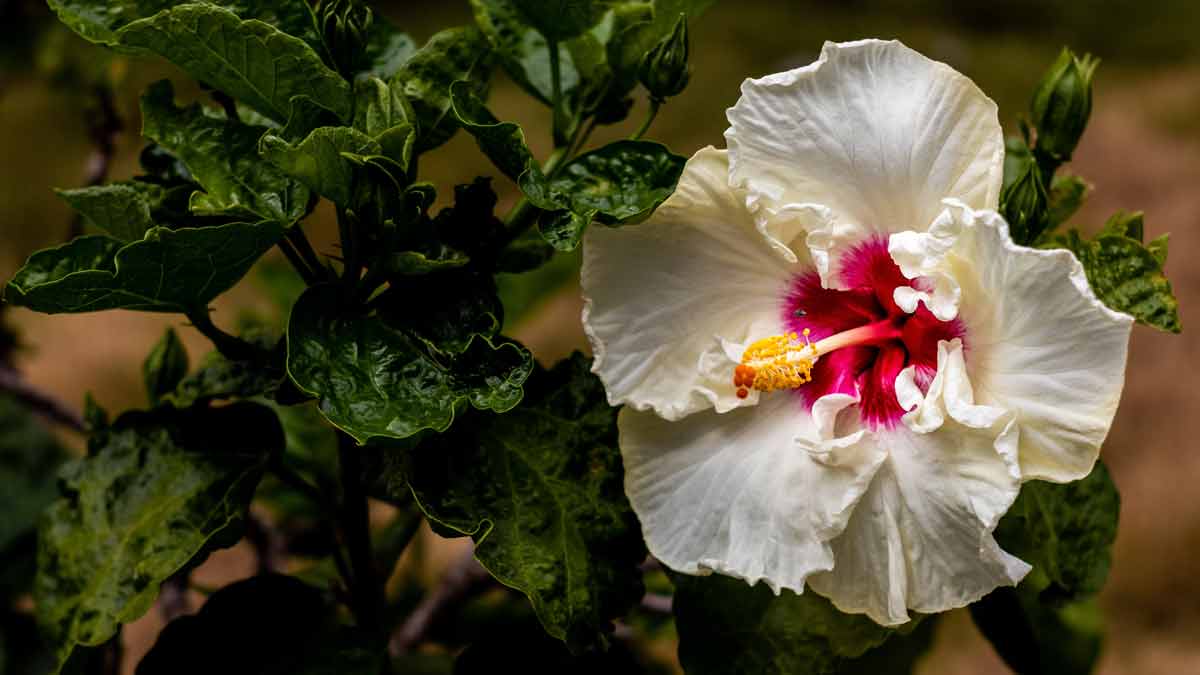Hibiscus can be overwatered easily, causing yellowing and leaf drop. To save an overwatered plant, let it dry out and trim damaged roots before repotting. Proper watering frequency and drainage are important for healthy hibiscus. Avoid mold or rot spots by emptying drip trays promptly.
Hibiscus plants are popular among plant enthusiasts for their vibrant and lush blooms.
Still, these tropical beauties require precise care to thrive.
One of the most common issues that hibiscus owners face is overwatering – a mistake that can lead to detrimental consequences if left unchecked.
In this easy-to-follow guide, we will discuss how to identify signs of an overwatered hibiscus plant, effective ways to revive it, and tips on preventing overwatering in the future.
With just a little knowledge and attention, you can ensure your hibiscus stays healthy and blossoms with stunning flowers for years.
Signs Of Overwatered Hibiscus Plants
When hibiscus plants are overwatered, they may show several signs indicating something is wrong.
The leaves may turn yellow and droop, the stems may become soft or mushy, and the soil may become damp and smelly.
Additionally, the plant may develop fungus or mold growth.
Identifying and addressing these symptoms promptly is important to prevent further damage to the plant.
Yellowing And Drooping Leaves
One of the most common signs that your hibiscus plant is suffering from overwatering is yellowing and drooping leaves.
Typically, healthy hibiscus leaves should be green and vibrant.
Still, they turn yellow when they receive too much water because the plant’s roots cannot absorb nutrients properly.
In addition to yellowing, hibiscus plants may also exhibit drooping leaves.
This occurs as the excess moisture compromises their root system’s ability to support proper growth, leaving them unable to hold up under their weight.
If you notice these telltale signs on your beloved tropical hibiscus or hardy hibiscus variety, it’s essential to address the issue quickly before further damage occurs.
Soft Or Mushy Stem
A soft or mushy stem in your hibiscus plant indicates overwatering, often linked to root rot caused by excess moisture.
Over time, the roots become deprived of oxygen and succumb to fungal infections that weaken them.
Consequently, this lackluster condition extends up the plant’s stem, losing its firmness and structure.
To rescue an overwatered plant with a mushy stem, remove it from its pot and gently clean away the wet soil around its roots.
Examine the root system for any parts affected by rot – they will be brown or black and have a distinct odor.
Carefully trim away these damaged areas using sterilized pruning shears to prevent further infection from spreading throughout healthy sections of roots and stems.
Afterward, repot the plant into fresh well-draining soil with excellent drainage capabilities as described above while adjusting watering frequency according to recommendations for tropical hibiscus plants.
Fungus Or Mold Growth
Overwatered hibiscus plants may become susceptible to fungus and mold growth, which can negatively impact the plant’s health and reduce its ability to bloom beautifully.
As excess moisture in the soil lingers, it creates a damp environment ideal for fungal spores to thrive, eventually turning white and leading to root rot or unsightly powdery mildew on the leaves, stems, and flowers.
To prevent fungal diseases from getting out of hand, addressing overwatering promptly and maintaining proper care practices, such as regularly removing spent flowers and sanitizing shears during pruning, is crucial.
Damp And Smelly Soil
If you notice a foul smell coming from your hibiscus plant’s soil, it could be a sign of overwatering.
Damp soil can cause roots to rot and lead to the formation of harmful bacteria or fungi that emit unpleasant odors.
In addition to smelling bad, waterlogged soil can prevent nutrients from reaching the plant’s roots and cause yellowing leaves.
To address this issue, check for proper drainage in the pot by looking at the holes under it.
If clogged or absent, add some stones or gravel at the bottom before filling with fresh potting mix.
For those who prefer organic methods, adding Epsom salt to the soil can help alleviate soggy conditions by improving drainage and providing magnesium for healthy foliage growth.
However, ensure not to go overboard as too much salt can harm plants instead of helping them thrive.
How To Revive Overwatered Hibiscus Plants
If you’ve overwatered your hibiscus plant, don’t despair!
There are several steps you can take to revive it.
These include removing it from its pot, trimming affected roots and leaves, using appropriate soil, adjusting your watering routine, and using fungicide if needed.
Remove The Plant From Its Pot
When dealing with an overwatered hibiscus plant, it must be removed from its pot carefully.
Gently lift the plant from the soil and shake off any excess dirt.
Inspect the roots for signs of rot or damage – they will appear dark brown or black and may be mushy when touched.
Using a pair of clean shears, trim away any dead or damaged parts of the root system.
Additionally, prune back any wilted or yellowing leaves to prevent further stress on the plant.
These steps will help ensure that your overwatered plant fully recovers and thrives again.
Remember to keep monitoring your plant’s moisture levels moving forward and adjust your watering habits accordingly to avoid future instances of overwatering.
Trim Affected Roots And Leaves
If your hibiscus plant is suffering from overwatering and root rot, one way to revive it is by trimming affected roots and leaves.
Start by removing the plant from its pot and gently shaking off any excess soil.
Then, inspect the roots for signs of damage or rotting – these will appear black or brown and should be cut away with sharp scissors or pruners.
Next, remove any damaged leaves from the plant, as they can further stress the hibiscus.
Trimming back roots and leaves may seem drastic, but it can help stimulate new growth in healthy parts of the plant.
Finally, replant your hibiscus in fresh soil with good drainage and reduce the watering frequency until you see healthy new growth starting to emerge.
Use Well-draining And Nutrient-rich Soil
One of the critical steps in reviving overwatered hibiscus plants is using soil that drains well to prevent further damage.
This means choosing a potting mix specifically designed for tropical plants or adding perlite, sand, or pebbles to regular potting soil to improve drainage.
Also, hibiscus plants benefit from nutrient-rich soil providing essential minerals and organic matter.
Planting your hibiscus in the right-sized container is important because it can improve water retention and drainage.
In pots that are too small, excess moisture can build up more quickly than it can evaporate, leading to root rot and other problems.
Adjust Watering Frequency And Amount
To fix an overwatered hibiscus plant, one of the most crucial steps is to adjust your watering habits.
First, regularly check the soil moisture with a meter or finger test—only water when the soil is dry about an inch down.
It’s better to underwater than overwater as excess water can cause root rot and other problems.
Next, ensure the pot has adequate drainage holes in its bottom and remove any dish or tray underneath it that may catch excess water.
By adjusting your watering frequency and amount accordingly and ensuring proper drainage, you can help prevent overwatering in the future and keep your hibiscus plants healthy and happy.
Furthermore, using well-draining soil can also help absorb excess moisture before it causes harm to your plant’s roots.
Use Fungicide As Necessary
Sometimes, a fungicide may be necessary when reviving an overwatered plant.
This can help to prevent the growth of harmful fungi or molds that thrive in damp conditions.
When choosing a fungicide, it’s important to select one safe for use on hibiscus plants and follow the manufacturer’s instructions carefully.
Overwatering can lead to root rot and other severe issues in hibiscus plants.
By taking preventative measures and being proactive when signs of overwatering appear, you can ensure healthy growth and vibrant blooms from your beloved tropical plant.
Monitor soil moisture levels regularly, provide proper sunlight and ventilation, and adjust the watering frequency based on your specific climate conditions.
Prevention Tips For Overwatering
To maintain the health of your hibiscus plant and avoid overwatering, you can take several essential steps.
These include selecting the appropriate pot and soil, regularly checking soil moisture levels, ensuring adequate sunlight and ventilation, and promptly draining excess water.
By following these guidelines, you can ensure that your hibiscus plant thrives and remains healthy over time.
Read on for more information on caring for your hibiscus plants.
Choose The Right Pot And Soil
Selecting the appropriate pot and soil can help prevent overwatering in hibiscus plants.
Choosing a pot with good drainage holes is crucial to ensure excess water can escape, preventing waterlogging.
It’s also essential to pick the right pot size for your plant.
A pot that is too large will hold more moisture than required, causing overwatering.
Conversely, if the container is too small, it’ll become overcrowded quickly, leading to stunted growth and root rot.
Monitor Soil Moisture With A Moisture Meter Or Finger Test
One way to avoid overwatering your Hibiscus plant is by monitoring the moisture level in the soil.
This can be done using a moisture meter or a finger test.
A moisture meter will provide an accurate reading of how much water is in the soil and whether it needs watering.
It’s important to note that different Hibiscus plants have varying requirements regarding soil moisture levels.
For instance, tropical hibiscus plants need more water than their hardy counterparts.
Understanding your plant’s watering needs will help you balance underwatering and overwatering.
Drain Excess Water
Draining excess water is crucial for preventing overwatering in hibiscus plants.
After watering, allow the pot to drain thoroughly before returning it to its saucer or decorative cover, which can trap excess moisture and lead to root rot.
If you notice standing water in the saucer or tray after watering, carefully remove it.
Overwatered hibiscus plants often suffer from soggy soil conditions that can result in yellowing leaves and root rot.
Properly draining excess water will help mitigate these issues and keep your hibiscus healthy and thriving year-round.
Ensure Proper Sunlight And Ventilation
Proper sunlight and ventilation are essential for hibiscus plants to thrive and prevent overwatering.
These tropical beauties need at least six hours of bright, direct sunlight to produce large, vibrant blooms.
However, too much sun exposure can cause the leaves to wilt and burn.
In addition to adequate sunlight, proper ventilation is vital in maintaining healthy hibiscus plants.
Good air circulation prevents the stagnation of moisture around the foliage and soil surface, reducing the risk of fungal growth and insect infestation.
You can achieve this by placing fans near indoor plants or planting outdoor ones away from crowded areas with obstructions that hinder airflow.
Final Thoughts
Identifying and fixing overwatered hibiscus is easier than it may sound.
By paying attention to signs of water damage and taking action promptly, you can revive your beloved tropical plant back to its healthy state.
Remember to choose the right pot and soil, monitor soil moisture regularly, adjust watering frequency appropriately, ensure proper sunlight and ventilation, and use fungicide when necessary.
With these prevention tips, you can keep your hibiscus blooming beautifully for years.







